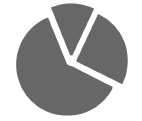
The Fundamentals of Investing
Asset allocation. The two words you’ll hear on Wall Street more than “big” and “bonuses.”
As an investor, asset allocation is one of those things you’ll want to know something about.
The good news is that you already know a lot about it!
What is an asset class?
Well, you may recall that the main asset classes are stocks, bonds, cash, and real estate. And sure, you learned about sub-asset classes, such as U.S. versus emerging markets, and small companies versus large companies, or long-term bonds versus short-term bonds. We know there are many ways we can slice this up into different categories.
But what about the allocation part?
Allocation basically means how things are divided up. Therefore, asset allocation is simply looking at your investments and answering these two questions:
1. What asset classes do I own?
2. How much of each asset class do I own?
That’s it. Do I own stocks? Yes. Okay, how much do I own? Do I own bonds? Yes. Okay, how much? Do I own cash? Yes. Okay, how much? Do I own real estate? No. Okay.
To make things easier, we look at what percentage of our total portfolio we own. We don’t usually say, “I own $52,456.43 in small cap emerging market stocks,” which doesn’t really mean that much. Is that a lot to own of small cap emerging market stocks, an asset class that is fairly risky? Uh, well, it’s hard to say.
It’s more meaningful to think about what percent of your total portfolio this asset is, rather than the actual dollar amount you own.
So, maybe that $52,456.43 you have invested in small cap emerging market stocks is 3% of your total investment portfolio. You know small cap emerging market stocks are pretty risky, but it looks like it only represents 3% of your total portfolio. That’s not too risky or crazy. But what if that $52,456.43 represented 96% of your portfolio?Holy cow! Pump the brakes! That’s almost your entire portfolio invested in a fairly risky asset.

And for our graphically minded folks, you’ll most often see an asset allocation pie chart that visually represents what you own.
Here’s a fun little ditty. You’ll often hear the phrase “asset allocation” as a noun. In other words, this is my asset allocation. This means, here is how my portfolio is invested.
But you’ll also hear “asset allocation” as a verb, as in the process of
allocating or dividing up your investments into different asset classes.
The takeaway is that asset allocation simply looks at your portfolio of investments and tells you what asset classes you own and what the percentage of each is in your overall portfolio. Asset allocation is a thing – here is my asset allocation – but it’s also a process.
The big question you may have is, “That’s all nice and good. Now I know what asset allocation is, but why should my investments be allocated?” And that, my friends, is a very good question. The answer may surprise you. In the next lesson, I make the case that asset allocation is for losers.
The proceeding blog post is an excerpt from Get Money Smart: Simple Lessons to Kickstart Your Financial Confidence & Grow Your Wealth, available now on Amazon.


About the Independent Financial Advisor
Robert Pagliarini, PhD, CFP® has helped clients across the United States manage, grow, and preserve their wealth for nearly three decades. His goal is to provide comprehensive financial, investment, and tax advice in a way that is honest and ethical. In addition, he is a CFP® Board Ambassador, one of only 50 in the country, and a fiduciary. In his spare time, he writes personal finance books. With decades of experience as a financial advisor, the media often calls on him for his expertise. Contact Robert today to learn more about his financial planning services.



